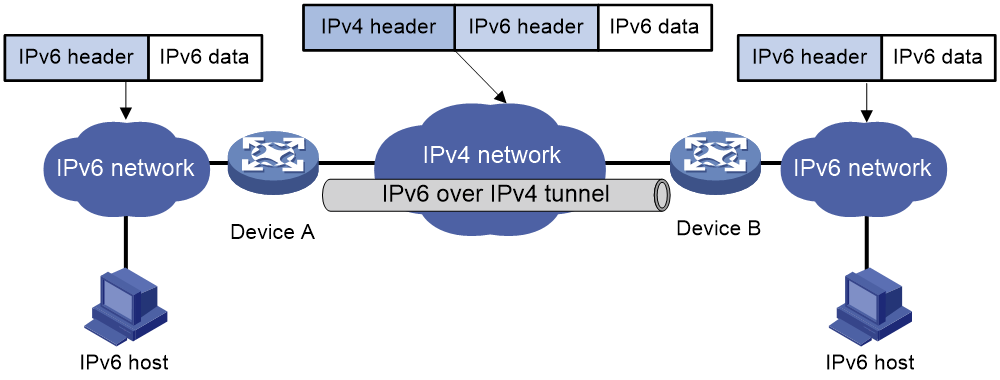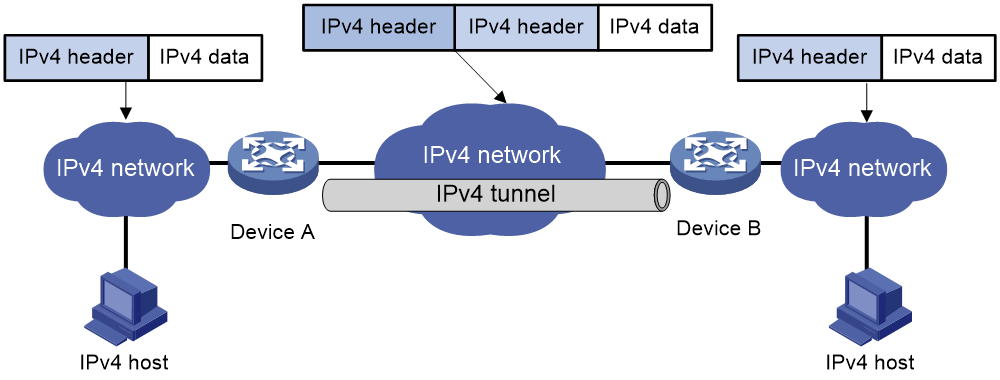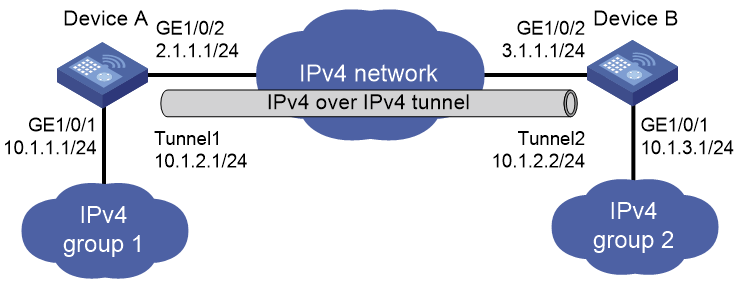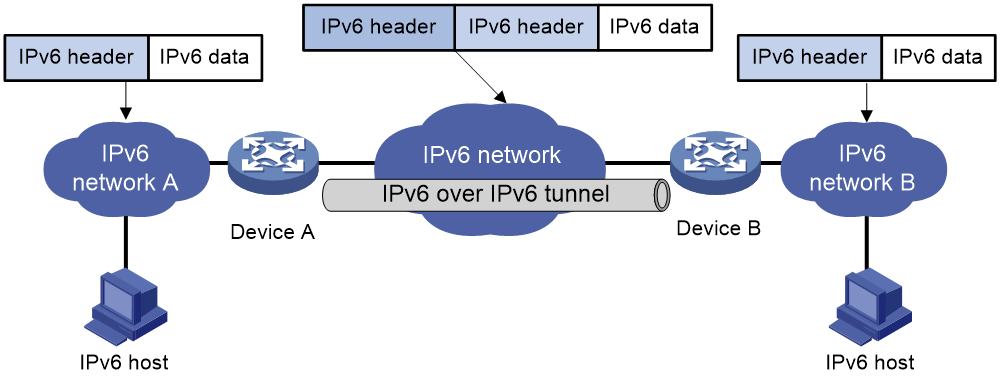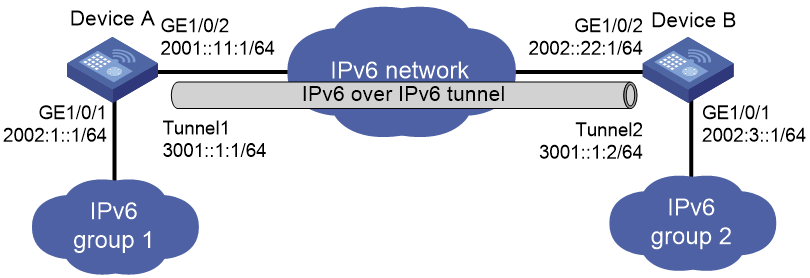- Table of Contents
-
- 05-Network Connectivity Configuration Guide
- 00-Preface
- 01-MAC address table configuration
- 02-Ethernet link aggregation configuration
- 03-VLAN configuration
- 04-Loop detection configuration
- 05-Spanning tree configuration
- 06-LLDP configuration
- 07-Layer 2 forwarding configuration
- 08-VLAN termination configuration
- 09-PPP configuration
- 10-L2TP configuration
- 11-ARP configuration
- 12-IP addressing configuration
- 13-DHCP configuration
- 14-DHCPv6 configuration
- 15-DNS configuration
- 16-NAT configuration
- 17-IP performance optimization configuration
- 18-IPv6 basics configuration
- 19-GRE configuration
- 20-Tunneling configuration
- 21-Basic IP routing configuration
- 22-IP forwarding basics configuration
- 23-Static routing configuration
- 24-IPv6 static routing configuration
- 25-Policy-based routing configuration
- 26-IPv6 policy-based routing configuration
- 27-RIP configuration
- 28-RIPng configuration
- 29-Multicast overview
- 30-IGMP snooping configuration
- 31-MLD snooping configuration
- Related Documents
-
| Title | Size | Download |
|---|---|---|
| 20-Tunneling configuration | 190.33 KB |
Contents
Restrictions and guidelines: Tunnel interface configuration
Configuring a tunnel interface
About tunnel interface configuration
Tunnel interface configuration tasks at a glance
Configuring parameters for tunneled packets
Restoring the default settings of a tunnel interface
Display and maintenance commands for tunnel interface configuration
Troubleshooting tunnel interface configuration
About IPv6 over IPv4 tunneling
Configuring an IPv6 over IPv4 manual tunnel
Example: Configuring an IPv6 over IPv4 manual tunnel
About IPv4 over IPv4 tunneling
Restrictions and guidelines: IPv4 over IPv4 tunnel configuration
Configuring an IPv4 over IPv4 tunnel
IPv4 over IPv4 tunnel configuration examples
Example: Configuring an IPv4 over IPv4 tunnel
About IPv6 over IPv6 tunneling
Restrictions and guidelines: IPv6 over IPv6 tunnel configuration
Configuring an IPv6 over IPv6 tunnel
IPv6 over IPv6 tunnel configuration examples
Example: Configuring an IPv6 over IPv6 tunnel
Configuring tunneling
This chapter describes tunnel interface configuration. For information about tunnel modes, see the subsequent chapters.
About tunneling
Tunneling encapsulates the packets of a network protocol within the packets of a second network protocol and transfers them over a virtual point-to-point connection. The virtual connection is called a tunnel. Packets are encapsulated at the tunnel source and de-encapsulated at the tunnel destination.
Restrictions and guidelines: Tunnel interface configuration
If the length for the tunnel headers of a packet is too long, the device might fail to process the packet. As a best practice, the number of nested encapsulations for a packet cannot exceed 5.
Configuring a tunnel interface
About tunnel interface configuration
Configure a tunnel interface (Layer 3 virtual interface) at both ends of a tunnel. The devices use the tunnel interface to identify, process, and send packets for the tunnel.
Tunnel interface configuration tasks at a glance
To configure a tunnel interface, perform the following tasks:
1. Creating a tunnel interface
2. (Optional.) Configuring parameters for tunneled packets
3. (Optional.) Restoring the default settings of a tunnel interface
Creating a tunnel interface
1. Enter system view.
system-view
2. Create a tunnel interface, specify the tunnel mode, and enter tunnel interface view.
interface tunnel number mode { gre [ ipv6 ] | gre-p2mp [ ipv6 ] | ipv4-ipv4 | ipv6-ipv4 | ipv6-ipv6 }
For packet tunneling to succeed, the two ends of a tunnel must use the same tunnel mode.
3. Configure a source address or source interface for the tunnel.
source { ipv4-address | ipv6-address | interface-type interface-number }
By default, no source address or source interface is configured for a tunnel.
If you specify a source address, it is used as the source address of tunneled packets.
If you specify a source interface, the primary IP address of this interface is used as the source IP address of tunneled packets.
4. Configure a destination address for the tunnel.
destination { ipv4-address | ipv6-address }
By default, no destination address is configured for a tunnel.
The tunnel destination address must be the IP address of the receiving interface on the tunnel peer. It is used as the destination IP address of tunneled packets.
5. (Optional.) Configure a description for the interface.
description text
By default, the description for a tunnel interface is Tunnel number Interface.
6. (Optional.) Set the MTU of the tunnel interface.
mtu size
The default settings are as follows:
¡ If the tunnel interface has never been up, the MTU is 64000 bytes.
¡ If the tunnel interface is up, its MTU is identical to the outgoing interface's MTU minus the length of the tunnel headers. The outgoing interface is automatically obtained through routing table lookup based on the tunnel destination address.
7. (Optional.) Set the expected bandwidth for the tunnel interface.
bandwidth bandwidth-value
The default expected bandwidth (in kbps) is the interface maximum rate divided by 1000.
The expected bandwidth is an informational parameter used only by higher-layer protocols for calculation. You cannot adjust the actual bandwidth of an interface by using this command.
8. Bring up the tunnel interface.
undo shutdown
By default, a tunnel interface is not administratively down.
Configuring parameters for tunneled packets
1. Enter system view.
system-view
2. Enter tunnel interface view.
interface tunnel number
3. Set the ToS for tunneled packets.
tunnel tos tos-value
By default, the ToS of tunneled packets is the same as that of the original packets.
4. Set the TTL for tunneled packets.
tunnel ttl ttl-value
The default TTL for tunneled packets is 255.
Restoring the default settings of a tunnel interface
Restrictions and guidelines
|
CAUTION: This operation might interrupt ongoing network services. Make sure you are fully aware of the impact of this operation when you perform it on a live network. |
This operation might fail to restore the default settings for some commands for reasons such as command dependencies or system restrictions. Use the display this command in interface view to identify these commands. Use their undo forms or follow the command reference to restore their default settings. If your restoration attempt still fails, follow the error message instructions to resolve the problem.
Procedure
1. Enter system view.
system-view
2. Enter tunnel interface view.
interface tunnel number
3. Restore the default settings of the tunnel interface.
default
Display and maintenance commands for tunnel interface configuration
Execute display commands in any view and reset commands in user view.
|
Task |
Command |
Remarks |
|
Display information about tunnel interfaces. |
display interface [ tunnel [ number ] ] [ brief [ description | down ] ] |
N/A |
|
Display IPv6 information on tunnel interfaces. |
display ipv6 interface [ tunnel [ number ] ] [ brief ] |
For more information about this command, see IPv6 basics in Network Connectivity Command Reference. |
|
Clear statistics on tunnel interfaces. |
reset counters interface [ tunnel [ number ] ] |
N/A |
|
Clear IPv6 statistics on tunnel interfaces. |
reset ipv6 statistics |
For more information about this command, see IPv6 basics in Network Connectivity Command Reference. |
Troubleshooting tunnel interface configuration
Tunnel interface not up
Symptom
A tunnel interface configured with related parameters such as tunnel source address, tunnel destination address, and tunnel mode cannot come up.
Analysis
The physical interface of the tunnel does not come up, or the tunnel destination is unreachable.
Solution
1. To resolve the problem:
¡ Use the display interface or display ipv6 interface command to verify that the physical interface of the tunnel is up. If the physical interface is down, check the network connection.
¡ Use the display ipv6 routing-table or display ip routing-table command to verify that the tunnel destination is reachable. If the route is not available, configure a route to reach the tunnel destination.
2. If the problem persists, contact H3C Support.
IPv6 over IPv4 tunneling
About IPv6 over IPv4 tunneling
Implementation
IPv6 over IPv4 tunneling enables isolated IPv6 networks to communicate, as shown in Figure 1.
|
|
NOTE: The devices at both ends of an IPv6 over IPv4 tunnel must support the IPv4/IPv6 dual stack. |
Figure 1 IPv6 over IPv4 tunnel
The IPv6 over IPv4 tunnel processes packets by using the following steps:
1. A host in the IPv6 network sends an IPv6 packet to Device A at the tunnel source.
2. After Device A receives the IPv6 packet, it processes the packet as follows:
a. Searches the routing table to identify the outgoing interface for the IPv6 packet.
The outgoing interface is the tunnel interface, so Device A knows that the packet needs to be forwarded through the tunnel.
b. Adds an IPv4 header to the IPv6 packet and forwards the packet through the physical interface of the tunnel.
In the IPv4 header, the source IPv4 address is the IPv4 address of the tunnel source, and the destination IPv4 address is the IPv4 address of the tunnel destination.
3. Upon receiving the packet, Device B de-encapsulates the packet.
4. If the destination address of the IPv6 packet is itself, Device B forwards it to the upper-layer protocol. If it is not, Device B forwards it according to the routing table.
Configuring an IPv6 over IPv4 manual tunnel
Restrictions and guidelines
When you perform tasks in this section, follow these restrictions and guidelines:
· The tunnel destination address specified on the local device must be identical with the tunnel source address specified on the tunnel peer device.
· Do not specify the same tunnel source and destination addresses for different tunnels in the same mode on a device.
· To ensure correct packet forwarding, identify whether the destination IPv6 network and the IPv6 address of the local tunnel interface are on the same subnet. If they are not, configure a route reaching the destination IPv6 network through the tunnel interface. You can configure the route by using one of the following methods:
¡ Configure a static route, and specify the local tunnel interface as the egress interface or specify the IPv6 address of the peer tunnel interface as the next hop.
¡ Enable a dynamic routing protocol on both the local and remote tunnel interfaces.
For more information, see "Configuring IPv6 static routing" and the dynamic routing protocol configuration in Network Connectivity Configuration Guide.
Procedure
1. Enter system view.
system-view
2. Enter IPv6 over IPv4 manual tunnel interface view.
interface tunnel number [ mode ipv6-ipv4 ]
3. Specify an IPv6 address for the tunnel interface.
See "Configuring basic IPv6 settings."
4. Configure a source address or source interface for the tunnel.
source { ipv4-address | interface-type interface-number }
By default, no source address or source interface is configured for a tunnel.
If you specify a source address, it is used as the source IP address of tunneled packets.
If you specify a source interface, the primary IP address of this interface is used as the source IP address of tunneled packets.
5. Configure a destination address for the tunnel.
destination ipv4-address
By default, no destination address is configured for a tunnel.
The tunnel destination address must be the IP address of the receiving interface on the tunnel peer. It is used as the destination IP address of tunneled packets.
6. (Optional.) Set the DF bit for tunneled packets.
tunnel dfbit enable
By default, the DF bit is not set for tunneled packets.
Example: Configuring an IPv6 over IPv4 manual tunnel
Network configuration
As shown in Figure 2, configure an IPv6 over IPv4 tunnel between Device A and Device B so the two IPv6 networks can reach each other over the IPv4 network. Because the tunnel destination IPv4 address cannot be automatically obtained from the destination IPv6 addresses, configure an IPv6 over IPv4 manual tunnel.
Prerequisites
Make sure Device A and Device B can reach each other through IPv4.
Procedure
1. Configure Device A:
# Assign an IPv4 address to interface GigabitEthernet 1/0/2.
<DeviceA> system-view
[DeviceA] interface gigabitethernet 1/0/2
[DeviceA-GigabitEthernet1/0/2] ip address 192.168.100.1 255.255.255.0
[DeviceA-GigabitEthernet1/0/2] quit
# Assign an IPv6 address to interface GigabitEthernet 1/0/1.
[DeviceA] interface gigabitethernet 1/0/1
[DeviceA-GigabitEthernet1/0/1] ipv6 address 3002::1 64
[DeviceA-GigabitEthernet1/0/1] quit
# Create IPv6 over IPv4 manual tunnel interface Tunnel 0.
[DeviceA] interface tunnel 0 mode ipv6-ipv4
# Specify an IPv6 address for the tunnel interface.
[DeviceA-Tunnel0] ipv6 address 3001::1/64
# Specify GigabitEthernet 1/0/2 as the source interface of the tunnel.
[DeviceA-Tunnel0] source gigabitethernet 1/0/2
# Specify the IP address of GigabitEthernet 1/0/2 on Device B as the destination address of the tunnel.
[DeviceA-Tunnel0] destination 192.168.50.1
[DeviceA-Tunnel0] quit
# Configure a static route destined for IPv6 network 2 through Tunnel 0.
[DeviceA] ipv6 route-static 3003:: 64 tunnel 0
2. Configure Device B:
# Assign an IPv4 address to interface GigabitEthernet 1/0/2.
<DeviceB> system-view
[DeviceB] interface gigabitethernet 1/0/2
[DeviceB-GigabitEthernet1/0/2] ip address 192.168.50.1 255.255.255.0
[DeviceB-GigabitEthernet1/0/2] quit
# Assign an IPv6 address to interface GigabitEthernet 1/0/1.
[DeviceB] interface gigabitethernet 1/0/1
[DeviceB-GigabitEthernet1/0/1] ipv6 address 3003::1 64
[DeviceB-GigabitEthernet1/0/1] quit
# Create IPv6 over IPv4 manual tunnel interface Tunnel 0.
[DeviceB] interface tunnel 0 mode ipv6-ipv4
# Specify an IPv6 address for the tunnel interface.
[DeviceB-Tunnel0] ipv6 address 3001::2/64
# Specify GigabitEthernet 1/0/2 as the source interface of the tunnel.
[DeviceB-Tunnel0] source gigabitethernet 1/0/2
# Specify the IP address of GigabitEthernet 1/0/2 on Device A as the destination address of the tunnel.
[DeviceB-Tunnel0] destination 192.168.100.1
[DeviceB-Tunnel0] quit
# Configure a static route destined for IPv6 network 1 through Tunnel 0.
[DeviceB] ipv6 route-static 3002:: 64 tunnel 0
Verifying the configuration
# Use the display ipv6 interface command to display tunnel interface status on Device A and Device B. Verify that interface Tunnel 0 is up. (Details not shown.)
# Verify that Device A and Device B can ping the IPv6 address of GigabitEthernet 1/0/1 of each other. This example uses Device A.
[DeviceA] ping ipv6 3003::1
Ping6(56 data bytes) 3001::1 --> 3003::1, press CTRL_C to break
56 bytes from 3003::1, icmp_seq=0 hlim=64 time=45.000 ms
56 bytes from 3003::1, icmp_seq=1 hlim=64 time=10.000 ms
56 bytes from 3003::1, icmp_seq=2 hlim=64 time=4.000 ms
56 bytes from 3003::1, icmp_seq=3 hlim=64 time=10.000 ms
56 bytes from 3003::1, icmp_seq=4 hlim=64 time=11.000 ms
--- Ping6 statistics for 3003::1 ---
5 packet(s) transmitted, 5 packet(s) received, 0.0% packet loss
round-trip min/avg/max/std-dev = 4.000/16.000/45.000/14.711 ms
IPv4 over IPv4 tunneling
About IPv4 over IPv4 tunneling
IPv4 over IPv4 tunneling (RFC 1853) enables isolated IPv4 networks to communicate. For example, an IPv4 over IPv4 tunnel can connect isolated private IPv4 networks over a public IPv4 network.
Figure 3 IPv4 over IPv4 tunnel
Figure 3 shows the encapsulation and de-encapsulation processes.
· Encapsulation:
a. Device A receives an IP packet from an IPv4 host and submits it to the IP protocol stack.
b. The IPv4 protocol stack determines how to forward the packet according to the destination address in the IP header. If the packet is destined for the IPv4 host connected to Device B, Device A delivers the packet to the tunnel interface.
c. The tunnel interface adds a new IPv4 header to the IPv4 packet and submits it to the IP protocol stack.
In the new header, the source IP address specifies the tunnel source, and the destination IP address specifies the tunnel destination.
d. The IP protocol stack uses the destination IP address of the new IP header to look up the routing table, and then sends the packet out.
· De-encapsulation:
a. After receiving the packet, Device B delivers it to the IP protocol stack.
b. If the protocol number is 4 (indicating an IPv4 packet is encapsulated within the packet), the IP protocol stack delivers the packet to the tunnel module for de-encapsulation.
c. The tunnel module de-encapsulates the IP packet and sends it back to the IP protocol stack.
d. The protocol stack forwards the de-encapsulated packet.
Restrictions and guidelines: IPv4 over IPv4 tunnel configuration
Follow these guidelines when you configure an IPv4 over IPv4 tunnel:
· The tunnel destination address specified on the local device must be identical with the tunnel source address specified on the tunnel peer device.
· Do not specify the same tunnel source and destination addresses for tunnels of the same tunnel mode.
· The IPv4 address of the local tunnel interface cannot be on the same subnet as the destination address configured on the tunnel interface.
· To ensure correct packet forwarding, identify whether the destination IPv4 network and the IPv4 address of the local tunnel interface are on the same subnet. If they are not, configure a route reaching the destination IPv4 network through the tunnel interface. You can configure the route by using one of the following methods:
¡ Configure a static route, and specify the local tunnel interface as the egress interface or specify the IPv4 address of the peer tunnel interface as the next hop.
¡ Enable a dynamic routing protocol on both the local and remote tunnel interfaces.
For more information about route configuration, see "Configuring static routing" and the dynamic routing protocol configuration in Network Connectivity Configuration Guide.
· The destination address of the route passing the tunnel interface cannot be on the same subnet as the destination address configured on the tunnel interface.
Configuring an IPv4 over IPv4 tunnel
1. Enter system view.
system-view
2. Enter IPv4 over IPv4 tunnel interface view.
interface tunnel number [ mode ipv4-ipv4 ]
3. Configure an IPv4 address for the tunnel interface.
ip address ip-address { mask | mask-length } [ sub ]
4. Configure a source address or source interface for the tunnel.
source { ipv4-address | interface-type interface-number }
By default, no source address or source interface is configured for a tunnel.
If you specify a source address, it is used as the source IP address of tunneled packets.
If you specify a source interface, the primary IP address of this interface is used as the source IP address of tunneled packets.
5. Configure a destination address for the tunnel.
destination ipv4-address
By default, no destination address is configured for a tunnel.
The tunnel destination address must be the IP address of the receiving interface on the tunnel peer. It is used as the destination IP address of tunneled packets.
6. (Optional.) Set the DF bit for tunneled packets.
tunnel dfbit enable
By default, the DF bit is not set for tunneled packets.
IPv4 over IPv4 tunnel configuration examples
Example: Configuring an IPv4 over IPv4 tunnel
Network configuration
As shown in Figure 4, the two subnets IPv4 group 1 and IPv4 group 2 use private IPv4 addresses. Configure an IPv4 over IPv4 tunnel between Device A and Device B to make the two subnets reachable to each other.
Prerequisites
Make sure Device A and Device B can reach each other through IPv4.
Procedure
1. Configure Device A:
# Assign an IP address to interface GigabitEthernet 1/0/1.
<DeviceA> system-view
[DeviceA] interface gigabitethernet 1/0/1
[DeviceA-GigabitEthernet1/0/1] ip address 10.1.1.1 255.255.255.0
[DeviceA-GigabitEthernet1/0/1] quit
# Assign an IP address to interface GigabitEthernet 1/0/2, the physical interface of the tunnel.
[DeviceA] interface gigabitethernet 1/0/2
[DeviceA-GigabitEthernet1/0/2] ip address 2.1.1.1 255.255.255.0
[DeviceA-GigabitEthernet1/0/2] quit
# Create IPv4 over IPv4 tunnel interface Tunnel 1.
[DeviceA] interface tunnel 1 mode ipv4-ipv4
# Specify an IP address for the tunnel interface.
[DeviceA-Tunnel1] ip address 10.1.2.1 255.255.255.0
# Specify the IP address of GigabitEthernet 1/0/2 as the source address of the tunnel.
[DeviceA-Tunnel1] source 2.1.1.1
# Specify the IP address of GigabitEthernet 1/0/2 on Device B as the destination address of the tunnel.
[DeviceA-Tunnel1] destination 3.1.1.1
[DeviceA-Tunnel1] quit
# Configure a static route destined for IPv4 group 2 through the tunnel.
[DeviceA] ip route-static 10.1.3.0 255.255.255.0 tunnel 1
2. Configure Device B:
# Assign an IP address to interface GigabitEthernet 1/0/1.
<DeviceB> system-view
[DeviceB] interface gigabitethernet 1/0/1
[DeviceB-GigabitEthernet1/0/1] ip address 10.1.3.1 255.255.255.0
[DeviceB-GigabitEthernet1/0/1] quit
# Assign an IP address to interface GigabitEthernet 1/0/2, the physical interface of the tunnel.
[DeviceB] interface gigabitethernet 1/0/2
[DeviceB-GigabitEthernet1/0/2] ip address 3.1.1.1 255.255.255.0
[DeviceB-GigabitEthernet1/0/2] quit
# Create IPv4 over IPv4 tunnel interface Tunnel 2.
[DeviceB] interface tunnel 2 mode ipv4-ipv4
# Specify an IP address for the tunnel interface.
[DeviceB-Tunnel2] ip address 10.1.2.2 255.255.255.0
# Specify the IP address of GigabitEthernet 1/0/2 as the source address of the tunnel.
[DeviceB-Tunnel2] source 3.1.1.1
# Specify the IP address of GigabitEthernet 1/0/2 on Device A as the destination address of the tunnel.
[DeviceB-Tunnel2] destination 2.1.1.1
[DeviceB-Tunnel2] quit
# Configure a static route destined for IPv4 group 1 through the tunnel.
[DeviceB] ip route-static 10.1.1.0 255.255.255.0 tunnel 2
Verifying the configuration
# Use the display interface tunnel command to display the status of the tunnel interfaces on Device A and Device B. Verify that the tunnel interfaces are up. (Details not shown.)
# Verify that Device A and Device B can ping the IPv4 address of interface GigabitEthernet 1/0/1 of each other. This example uses Device A.
[DeviceA] ping -a 10.1.1.1 10.1.3.1
Ping 10.1.3.1 (10.1.3.1) from 10.1.1.1: 56 data bytes, press CTRL_C to break
56 bytes from 10.1.3.1: icmp_seq=0 ttl=255 time=2.000 ms
56 bytes from 10.1.3.1: icmp_seq=1 ttl=255 time=1.000 ms
56 bytes from 10.1.3.1: icmp_seq=2 ttl=255 time=0.000 ms
56 bytes from 10.1.3.1: icmp_seq=3 ttl=255 time=1.000 ms
56 bytes from 10.1.3.1: icmp_seq=4 ttl=255 time=1.000 ms
--- Ping statistics for 10.1.3.1 ---
5 packet(s) transmitted, 5 packet(s) received, 0.0% packet loss
round-trip min/avg/max/std-dev = 0.000/1.000/2.000/0.632 ms
IPv6 over IPv6 tunneling
About IPv6 over IPv6 tunneling
IPv6 over IPv6 tunneling (RFC 2473) enables isolated IPv6 networks to communicate with each other over another IPv6 network. For example, two isolated IPv6 networks that do not want to show their addresses to the Internet can use an IPv6 over IPv6 tunnel to communicate with each other.
Figure 5 Principle of IPv6 over IPv6 tunneling
Figure 5 shows the encapsulation and de-encapsulation processes.
· Encapsulation:
a. After receiving an IPv6 packet, Device A submits it to the IPv6 protocol stack.
b. The IPv6 protocol stack uses the destination IPv6 address of the packet to find the egress interface. If the egress interface is the tunnel interface, the stack delivers it to the tunnel interface.
c. After receiving the packet, the tunnel interface adds an IPv6 header to it and submits it to the IPv6 protocol stack.
d. The IPv6 protocol stack forwards the packet according to its destination IPv6 address.
· De-encapsulation:
a. Upon receiving the IPv6 packet, Device B delivers it to the IPv6 protocol stack.
b. The IPv6 protocol stack checks the protocol type of the data portion encapsulated in the IPv6 packet. If the encapsulation protocol is IPv6, the stack delivers the packet to the tunnel module.
c. The tunnel module de-encapsulates the packet and sends it back to the IPv6 protocol stack.
d. The IPv6 protocol stack forwards the IPv6 packet.
Restrictions and guidelines: IPv6 over IPv6 tunnel configuration
Follow these guidelines when you configure an IPv6 over IPv6 tunnel:
· The tunnel destination address specified on the local device must be identical with the tunnel source address specified on the tunnel peer device.
· Do not specify the same tunnel source and destination addresses for tunnels of the same tunnel mode.
· The IPv6 address of the tunnel interface cannot be on the same subnet as the destination address configured for the tunnel interface.
· To ensure correct packet forwarding, identify whether the destination IPv6 network and the IPv6 address of the local tunnel interface are on the same subnet. If they are not, configure a route reaching the destination IPv6 network through the tunnel interface. You can configure the route by using one of the following methods:
¡ Configure a static route, and specify the local tunnel interface as the egress interface or specify the IPv6 address of the peer tunnel interface as the next hop.
¡ Enable a dynamic routing protocol on both the local and remote tunnel interfaces.
For more information about route configuration, see Network Connectivity Configuration Guide.
· The destination address of the route passing the tunnel interface cannot be on the same subnet as the destination address configured on the tunnel interface.
Configuring an IPv6 over IPv6 tunnel
1. Enter system view.
system-view
2. Enter IPv6 over IPv6 tunnel interface view.
interface tunnel number [ mode ipv6-ipv6 ]
3. Configure an IPv6 address for the tunnel interface.
See "Configuring basic IPv6 settings."
4. Configure a source address or source interface for the tunnel.
source { ipv6-address | interface-type interface-number }
By default, no source address or interface is configured for a tunnel.
If you specify a source address, it is used as the source IPv6 address of tunneled packets.
If you specify a source interface, the lowest IPv6 address of this interface is used as the source IPv6 address of tunneled packets.
5. Configure a destination address for the tunnel.
destination ipv6-address
By default, no destination address is configured for a tunnel.
The tunnel destination address must be the IPv6 address of the receiving interface on the tunnel peer. It is used as the destination IPv6 address of tunneled packets.
IPv6 over IPv6 tunnel configuration examples
Example: Configuring an IPv6 over IPv6 tunnel
Network configuration
As shown in Figure 6, configure an IPv6 over IPv6 tunnel between Device A and Device B so the IPv6 groups can reach each other without disclosing their IPv6 addresses.
Prerequisites
Make sure Device A and Device B can reach each other through IPv6.
Procedure
1. Configure Device A:
# Assign an IPv6 address to interface GigabitEthernet 1/0/1.
<DeviceA> system-view
[DeviceA] interface gigabitethernet 1/0/1
[DeviceA-GigabitEthernet1/0/1] ipv6 address 2002:1::1 64
[DeviceA-GigabitEthernet1/0/1] quit
# Assign an IPv6 address to interface GigabitEthernet 1/0/2, the physical interface of the tunnel.
[DeviceA] interface gigabitethernet 1/0/2
[DeviceA-GigabitEthernet1/0/2] ipv6 address 2001::11:1 64
[DeviceA-GigabitEthernet1/0/2] quit
# Create IPv6 over IPv6 tunnel interface Tunnel 1.
[DeviceA] interface tunnel 1 mode ipv6-ipv6
# Specify an IPv6 address for the tunnel interface.
[DeviceA-Tunnel1] ipv6 address 3001::1:1 64
# Specify the IP address of GigabitEthernet 1/0/2 as the source address of the tunnel.
[DeviceA-Tunnel1] source 2001::11:1
# Specify the IP address of GigabitEthernet 1/0/2 on Device B as the destination address of the tunnel.
[DeviceA-Tunnel1] destination 2002::22:1
[DeviceA-Tunnel1] quit
# Configure a static route destined for the IPv6 network group 2 through the tunnel.
[DeviceA] ipv6 route-static 2002:3:: 64 tunnel 1
2. Configure Device B:
# Assign an IPv6 address to interface GigabitEthernet 1/0/1.
<DeviceB> system-view
[DeviceB] interface gigabitethernet 1/0/1
[DeviceB-GigabitEthernet1/0/1] ipv6 address 2002:3::1 64
[DeviceB-GigabitEthernet1/0/1] quit
# Assign an IPv6 address to interface GigabitEthernet 1/0/2, the physical interface of the tunnel.
[DeviceB] interface gigabitethernet 1/0/2
[DeviceB-GigabitEthernet1/0/2] ipv6 address 2002::22:1 64
[DeviceB-GigabitEthernet1/0/2] quit
# Create IPv6 over IPv6 tunnel interface Tunnel 2.
[DeviceB] interface tunnel 2 mode ipv6-ipv6
# Specify an IPv6 address for the tunnel interface.
[DeviceB-Tunnel2] ipv6 address 3001::1:2 64
# Specify the IP address of GigabitEthernet 1/0/2 as the source address of the tunnel.
[DeviceB-Tunnel2] source 2002::22:1
# Specify the IP address of GigabitEthernet 1/0/2 on Device A as the destination address of the tunnel.
[DeviceB-Tunnel2] destination 2001::11:1
[DeviceB-Tunnel2] quit
# Configure a static route destined for the IPv6 network group 1 through the tunnel.
[DeviceB] ipv6 route-static 2002:1:: 64 tunnel 2
Verifying the configuration
# Use the display ipv6 interface command to display the status of the tunnel interfaces on Device A and Device B. Verify that the tunnel interfaces are up. (Details not shown.)
# Verify that Device A and Device B can ping the IPv6 address of interface GigabitEthernet 1/0/1 of each other. This example uses Device A.
[DeviceA] ping ipv6 -a 2002:1::1 2002:3::1
Ping6(56 data bytes) 2002:1::1 --> 2002:3::1, press CTRL_C to break
56 bytes from 2002:3::1, icmp_seq=0 hlim=64 time=9.000 ms
56 bytes from 2002:3::1, icmp_seq=1 hlim=64 time=1.000 ms
56 bytes from 2002:3::1, icmp_seq=2 hlim=64 time=0.000 ms
56 bytes from 2002:3::1, icmp_seq=3 hlim=64 time=0.000 ms
56 bytes from 2002:3::1, icmp_seq=4 hlim=64 time=0.000 ms
--- Ping6 statistics for 2002:3::1 ---
5 packet(s) transmitted, 5 packet(s) received, 0.0% packet loss
round-trip min/avg/max/std-dev = 0.000/2.000/9.000/3.521 ms

